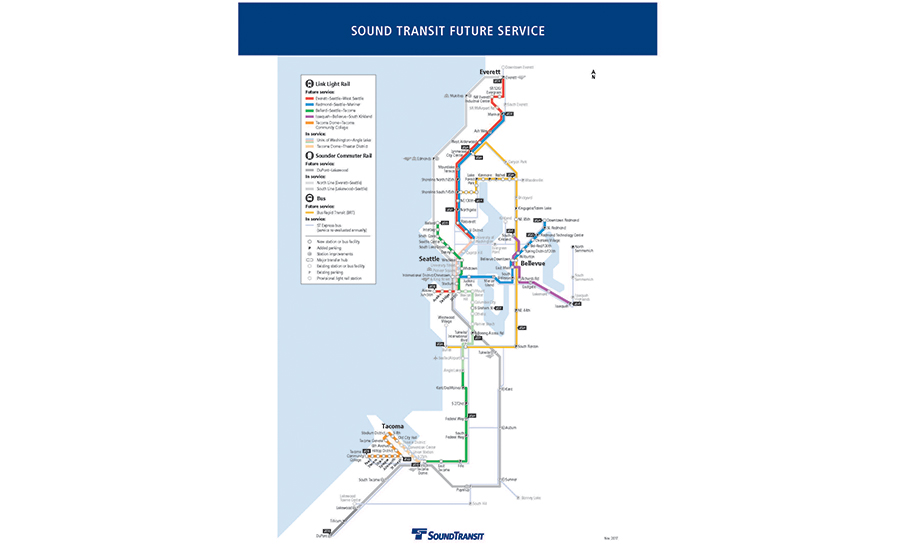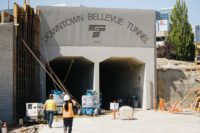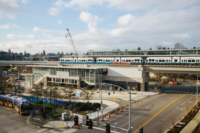Light rail is undergoing a multibillion, multi-decade expansion in the Puget Sound region, moving in all directions from Seattle through tunnels, over bridges and across bodies of water as Sound Transit pursues a dozen projects.
On the heels of a 2016 opening that sent light rail 3.15 miles—at a cost of $1.76 billion—to the University District from downtown, other major projects include a $1.89-billion, 4.3-mile extension to Northgate, expected to open in 2021; a 3.15-mile, $3.67-billion project to send light rail across Interstate 90’s floating bridge from Seattle to points east, including Bellevue; and an 8.5-mile, $2.77-billion project to extend to Lynnwood.
Other projects include a downtown Redmond link, an 11.8-mile extension to West Seattle and Ballard with nine stations and a rail-only tunnel downtown, a 1.6-mile extension south from SeaTac International Airport, an additional 7.8 miles in Federal Way, a 2.4-mile extension in Tacoma, a 9.7-mile extension between Federal Way and Tacoma, a new maintenance facility in Bellevue, and the addition of 182 vehicles.
In all, Sound Transit expects to spend $12.9 billion—on top of the $5 billion it has already spent—over three bond phases, with East Link and Lynnwood the two most costly projects.
The Lynnwood project budget was finalized in May and already has the joint venture of Stacey and Witbeck/Kiewit/Hoffman doing preliminary work for a 2024 projected opening. Main construction is split into north and south segments, one heading to bid in September and the other in the first quarter of 2019, says Rod Kempkes, Sound Transit executive project director. Following the construction manager/general contractor delivery method, he expects 100% design for the construction by the second quarter of 2019 for the elevated guideway, four stations and three parking garages. About half the project will be elevated and the other half will use a cut-and-fill method.
Already, though, cost has proved a tricky challenge. “Market conditions for property acquisitions, construction materials and labor continue to trend upward and place pressure on established budgets and schedules,” Kempkes says. He’s also working to secure a grant from the Federal Transit Administration. “Working within a constrained corridor along the edges of the I-5 freeway bounded by primarily residential areas also adds to the cost of construction,” he says. “Property acquisition and relocation is a major component of the overall cost.”
The alignment passes through four local jurisdictions within the right-of-way of Interstate 5, requiring a “great deal of coordination among staff as well as jurisdictional partners.”
Don Davis, executive project director for the Northgate Link project, says his project should include completion on three stations in March 2020 and be open for service in September 2021. The cost of the project has dropped over $2 million since it began, in part because an effort to increase contractor awareness on tunnel and station shafts resulted in bids well below the engineer’s estimate. He says right-of-way was procured early in the project and firm pricing on station contracts was obtained while construction costs were relatively stable.
During construction, Davis says the team successfully tunneled through Seattle’s mixed geological and hydro-geological ground conditions, built 23 tunnel cross-passages that required ground stabilization techniques such as grouting and soil freezing, and limited noise and vibration around sensitive research work at the University of Washington campus.
Moving forward, Davis says that “with multiple contractors working in limited, shared spaces, detailed scheduling and coordination of the remaining work will present challenges.”
The 14 miles and 10 stations involved in the East Link project, slated for a 2023 opening, gained a boost when engineers discovered how to place light rail across I90’s floating bridge. The route will connect Seattle’s International District to Mercer Island, Bellevue and Redmond.





Post a comment to this article
Report Abusive Comment